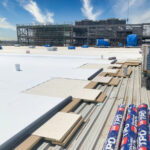Why are FM Approvals not more commonly used for risk management in flat roof construction?

Why are FM Approvals not more commonly used for risk management in flat roof construction?
Whilst FM Approvals is a global brand offering a third-party testing and verification service, it is perhaps not well known throughout all areas of the construction industry. There is sometimes a lack of awareness of the benefits that using FM Approved products and assemblies can bring to the risk management of flat roofing projects, especially single ply roof build ups.
FM Approvals is a subsidiary of FM Global, who are one of the leading insurers of commercial and industrial property. FM Global recommends the use of FM Approved products at all locations it insures, and this is also the case for many other commercial and industrial businesses insured through different providers.
The insurance industry, of course, is in the business of assessing and managing risk. The rigorous testing that FM Approved products and assemblies undergo brings the insurers a level of confidence about the performance and durability they can expect from the flat roof. The roof is a vital element of a building with respect to the damage and business disruption that can occur should it fail in any way.
FM Approval looks at the resilience of different flat roof assemblies when exposed to several key challenges they may experience during their operational life. The performance of the roof can then be mapped against different criteria, providing the specifier with a good indication of whether the roof will meet a projects risk profile and performance requirements.
How do FM Approved products and assemblies provide reassurance when specifying?
The reassurance is provided by the wide-ranging evaluation and testing that roofing products and assemblies must undergo before they can earn the right to become ‘FM Approved’.
The testing of roofing assemblies looks at how well each assembly can cope with the kind of circumstances that may result in the roof being compromised and therefore increasing the risk of business disruption.
Fire is one of the key risks that is assessed. The fire resistance of the roof is classified for exposure to fire from the outside of the roof through the waterproofing layer. It is also assessed for its ability to cope when the deck is exposed to fire from inside the building. Roofing assemblies that are better at slowing down the spread of heat along the deck reduce the risk of fire spreading before it can be brought under control. In some cases, in the USA, the classification of the FM Approved roof assembly when exposed to internal fire is factored into whether the building needs to install sprinkler systems. In Europe and within the UK, compliance to national and local building regulations must be followed and mean that the FM internal fire classification for a roof, although a useful performance indicator for specifiers does not remove them from their regulatory obligations.
The ability of the flat roof to offer protection against the weather is also a key element, as damage to a roof during a storm can expose the contents of the building to the elements causing costly disruption to the business and increased costs for the insurer. FM Approved assemblies are tested to see how well they resist the forces of wind-uplift that can try to pull the roof off a building during periods of high winds. Assemblies are also checked for their resistance to hail strikes, water ingress and resistance to corrosion of any metal components within the roof build-up.
Damage to a roof can occur from flying debris in a storm, however, it can also be caused by dropped tools during routine maintenance or installation of equipment on the roof. FM Approved assemblies are assessed for their ability to resist puncturing of the waterproof layer. They are also tested for their resistance to the effects of regular foot traffic on the roof surface that can occur on walkways and in maintenance areas.
All these tests give a comprehensive picture of the resilience of each approved roof assembly and provide reassurance to specifiers that the roof will perform as expected in a real-life scenario.
The products that make up each approved assembly cannot themselves claim to be ‘FM Approved’ although there is a process that manufacturers can go through to achieve this at the product level. It is a five-step process and involves the testing of the product, evaluation of the manufacturing process and checking that any claims made about the performance of the product are valid. Once a product achieves ‘FM Approved’ status, that is not the end for the manufacturer, as there is a requirement for regular audits by FM Approvals to ensure the quality and performance of the product is maintained. This also provides reassurance to specifiers that whether it is an FM Approved product or assembly, comprehensive testing and evaluation has taken place to ensure it meets the stated performance.
How can specifiers choose products and assemblies that are FM Approved?
FM Approved products can be found in the online FM Approval Guide and FM Approved assemblies are listed in ‘RoofNav’ an online database that enables specifiers to select assemblies by the particular performance criteria required for their projects.
DensDeck® Roof Boards and Roof Cover Boards are FM Approved and appear in hundreds of thousands of approved assemblies in RoofNav. Their incorporation into the roofing system enhances the fire protection, wind uplift and weather resistance of the overall assembly. If you would like to see how DensDeck® Roof Boards can help with your project, please contact one of the team today.
Contact Us
Start your project or simply get specification advice by dropping us a message.
One of our team will be in touch as soon as possible.